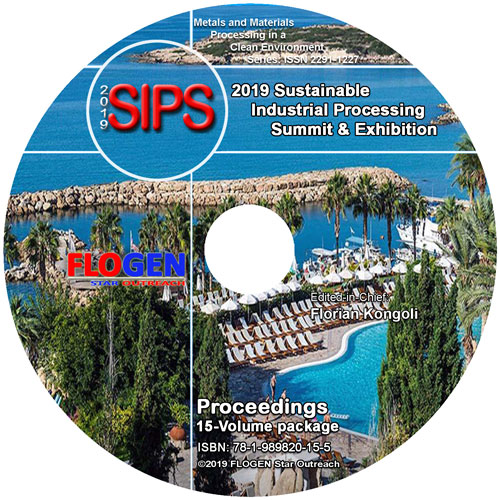2019-Sustainable Industrial Processing Summit
SIPS2019 Volume 8: Usui Intl. Symp. / Advanced Sustainable Iron and Steel Making
| Editors: | F. Kongoli, P. Assis, M.C. Gomez-Marroquin, S. Kitayama, H. Konishi, A. Murao, S. Nomura, H. Ono, H. Saxen, K. Seto, J.I. Tani |
| Publisher: | Flogen Star OUTREACH |
| Publication Year: | 2019 |
| Pages: | 250 pages |
| ISBN: | 978-1-989820-07-0 |
| ISSN: | 2291-1227 (Metals and Materials Processing in a Clean Environment Series) |

CD shopping page
Mathematical model of burden distribution in the blast furnace
Henrik Saxen1; Mikko Helle2; Haifeng Li3;1ABO AKADEMI UNIVERSITY, 20500 Abo, Finland; 2ABO AKADEMI UNIVERSITY, Abo, Finland; 3NORTHEASTERN UNIVERSITY, Shenyang, China;
Type of Paper: Keynote
Id Paper: 271
Topic: 2
Abstract:
The distribution of the burden plays a key role for the operation of the blast furnace [1], as it affects the thermal and chemical phenomena in the lumpy zone. Through these, the efficiency of heat and mass transfer and chemical reactions in the shaft are also affected. It also influences the level and shape of the cohesive zone, which has considerable impact on process stability and fuel rate. Therefore, many mathematical models (e.g., [2]) have been developed to gain understanding of the complex burden layer-formation process.
A mathematical model of the distribution of burden in a blast furnace with bell-less charging has been developed. Special attention was paid to the computation efficiency to make the model fast enough to allow for real-time simulation and interactive planning of charging programs. The model, which describes the formation of burden layers and their descent in the shaft of the furnace, has been verified by charging experiments at a small scale [3] and has been applied for automatic generation of charging programs satisfying certain criteria concerning the radial distribution of the burden [4].
The present paper presents some results where the model is applied to study new charging programs and the resulting distribution of coke and ore in the furnace shaft. Furthermore, the model's predictions of the distribution of burden layers are validated by comparison with measurements from a 3D top scanner in an operating furnace, through which the radial distribution of the layers can be measured. The model has been proven as a valuable tool in the design of charging programs and in the simulation of the distribution and descent of the burden layers in the throat and shaft regions of the blast furnace.
Keywords:
Iron; Modeling; Process; Technology;References:
[1] J.I. Park, H.J. Jung, M.K. Jo, H.S. Oh and J.W. Han, Met. Mater. Int. 17 (2011) 485-496.[2] V.R. Radhakrishnan, K.M. Ram, J. Proc. Control 11 (2001) 565-586.
[3] T. Mitra, H. Saxen, Metall. Mater. Trans. B 45B (2014) 2382-2394.
[4] T. Mitra, H. Saxen, Mater. Manuf. Proces. 30 (2015) 474-487.